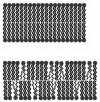Perspective: interesterified triglycerides, the recent increase in deaths from heart disease, and elevated blood viscosity
- PMID: 29265001
- PMCID: PMC5933641
- DOI: 10.1177/1753944717745507
Perspective: interesterified triglycerides, the recent increase in deaths from heart disease, and elevated blood viscosity
Abstract
The authors hypothesize that consumption of interesterified fats may be the cause of the continuous increase in cardiovascular deaths in the United States which began in 2011. Interesterification is a method of producing solid fats from vegetable oil and began to supplant partial hydrogenation for this purpose upon recognition of the danger of trans fats to cardiovascular health. Long, straight carbon chains, as are present in saturated and trans fatty acids, decrease the fluidity of the erythrocyte cell membrane, which decreases erythrocyte deformability and increases blood viscosity. This decrease in cell membrane fluidity is caused by increased van der Waals interactions, which also solidify dietary fats. Elevated blood viscosity is favored as the pathogenic mechanism by which trans fats increase cardiovascular mortality because changes in lipoprotein levels do not account for all the mortality attributable to their consumption. The rapid changes in cardiovascular mortality noted with the introduction and withdrawal of trans fats from the food supply are reviewed. The evidence implicating elevated blood viscosity in cardiovascular disease is also reviewed. Data regarding the production and consumption of interesterified fats in the US should be released in order to determine if there is an association with the observed increase in cardiovascular deaths.
Keywords: blood; deformability; erythrocyte; interesterification; lipids; trans; triglycerides; viscosity.
Conflict of interest statement
Figures



References
-
- Allday E. Damaging trans fat to be banished from US diet. SFGATE, http://www.sfgate.com/health/article/FDA-orders-trans-fat-removed-from-f... (2015, accessed 18 February 2017).
-
- Hayes KC, Pronczuk AJ. Replacing trans fat: the argument for palm oil with a cautionary note on interesterification. J Am Coll Nutr 2010; 29: 253S–284S. - PubMed
-
- Berry SEE, Miller GJ, Sanders TAB. The solid fat content of stearic acid-rich fats determines their postprandial effects. Am J Clin Nutr 2007; 85: 1486–1494. - PubMed
-
- Heron M, Anderson RN. Changes in the leading cause of death. Recent patterns in heart disease and cancer mortality. CDC, https://www.cdc.gov/nchs/products/databriefs/db254.htm (2016, accessed 19 January 2017). - PubMed
-
- Dalen JE, Alpert JS, Goldberg RJ, et al. The epidemic of the 20(th) century: coronary heart disease. Am J Med 2014; 127: 807–812. - PubMed
Publication types
MeSH terms
Substances
LinkOut - more resources
Full Text Sources
Other Literature Sources
Medical

